|
AUTOZINE TECHNICAL SCHOOL
Turbo + Supercharger - e.g. Volkswagen Twincharger As many people know, mechanical superchargers are good for low-end output but short of high-end efficiency, while exhaust turbochargers work strongly at high rev but reluctantly at low rev. For decades, engineers dreamed of combining supercharger and turbocharger together. In 1985, Lancia put such a complicated system into its Group B rally special, Delta S4. Despite of its motor racing success, Lancia had never put the technology into series production. It was the Japanese who did that first. In 1988, Nissan produced 10,000 units of March Super Turbo, whose tiny 1.0-liter engine utilized a Roots supercharger and a turbocharger to produce a respectable 110 ps. Nevertheless, it was never followed up since then. In 2005, Volkswagen resurrected the idea with the help of supercharger maker Eaton. Its 1.4-liter TSI direct injection engine was fitted with a turbocharger + supercharger system called "Twincharger". It produced 170 hp and 177 lbft of torque, about the same as a 2.3-liter naturally aspirated engine but consumed 20 percent less fuel. The engine was used extensively on Golf, Polo, Scirocco, Skoda Fabia, Seat Ibiza and Audi A1. This is the first really mass production of turbo + supercharger. 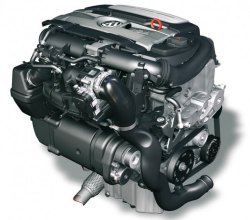 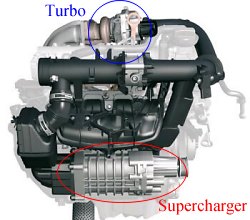 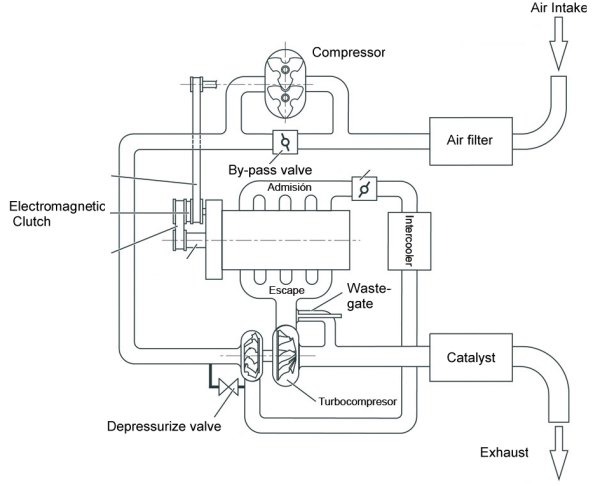 The construction of Twincharger is quite simple. It has a Roots supercharger and a turbocharger connected in series. The supercharger can be bypassed through an alternative path, or disengaged completely by an electromagnetic clutch. At low rev, the supercharger provides most of the boost pressure. The pressure it built up also helps spooling up the turbocharger so that the latter can run into operating range more quickly. At 1500 rpm, both chargers contribute about the same boost pressure, with a total of 2.5 bar. (Had the turbocharger worked alone, it could provide only 1.3 bar at the same rev) Then the turbocharger – which is optimized for high-rev power – started taking the lead. The higher the rev, the less efficient the Roots-type supercharger becomes. Therefore a by-pass valve depressurizes the supercharger gradually. By 3500 rpm, the turbocharger contributes all the boost pressure, thus the supercharger is disconnected by the electromagnetic clutch to save energy. The Twincharger is quite an achievement. It delivers excellent power and tractability yet the package is surprisingly compact. The only disadvantage is high cost. Predictably, it costs significantly more than a turbocharging system. As modern turbocharging has improved low-end response a lot, the significance of Twincharger is inevitably reduced. This prevents it from further penetration into the mass market. Electric Supercharger - e.g. Audi e-booster For a long time engineers have been dreaming of electric superchargers. A conventional mechanical supercharger is rather heavy and power consuming. The best way to use it is, like the Volkswagen Twincharger as described above, pair it with a turbocharger, using the supercharger to provide instant boost at low rpm and switching over to turbo once the latter gets up to speed. However, the installation is quite cumbersome, as you need gear or belt drive to connect the crankshaft to the supercharger, and an electromagnetic clutch to disengage it at higher rpms. If the supercharger is powered by an electric motor, then it can be installed anywhere and saving the accessories. The loss of mechanical drives also reduces vibration and noise a lot, which is probably the most criticized weakness of superchargers. In 2016, Audi SQ7 4.0TDI SUV became the first road car to adopt electric supercharger. The unit, called "e-booster" by the company, is supplied by Valeo: 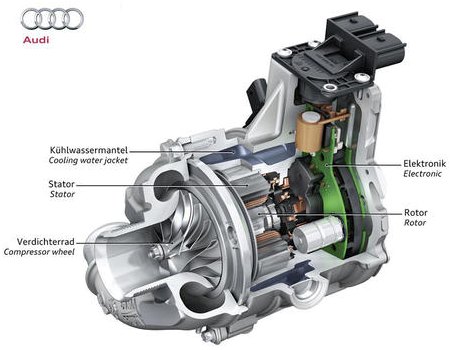 The e-booster uses a turbine like centrifugal supercharger or turbocharger. Thanks to its low inertia motor, it is capable to spin from rest to its maximum 70,000 rpm in just 250ms. This means it can provide full boost in merely a quarter of a second! In contrast, a mechanical supercharger spins proportionally to the engine crankshaft thus full boost only appears at higher rpms. Therefore, the e-boosted engine should show unprecedented response at the bottom end. In fact, that is exactly the case of the SQ7, which produces 664 lbft of torque at merely 1000 rpm! The e-booster is connected in series to a sequential twin-turbo system in the 4.0 TDI V8. It is positioned downstream of the intercooler as, unlike exhaust gas turbocharger, it does not generate much heat. At very low rpms, the e-booster is solely responsible for providing boost. It also helps spooling up the smaller turbo. When the small turbo gets up to speed, a bypass valve opens and drives the air flow away from the e-booster while the latter is turned off. At higher rpms, the big turbo joins the work to provide full boost. In other words, the function of e-booster is to fill the torque gap at the bottom end. It is not designed to work permanently, since exhaust turbocharging is more energy efficient. 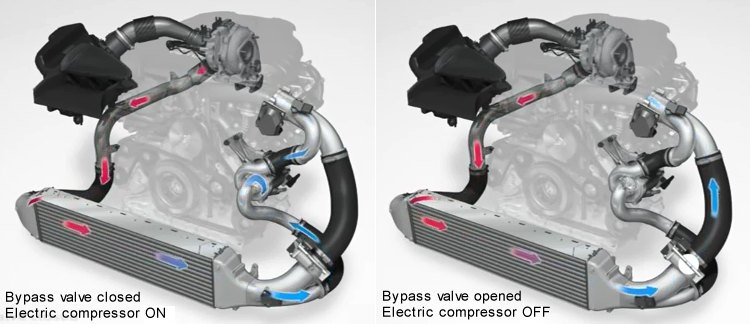 This e-boosted 3.0 TDI V6 was experiented in Audi RS5 prototype. It works similar to the SQ7's V8, just with a single turbo. On the downside, the e-booster consumes
7kW (9.5 hp). As conventional 12V electrical system is not powerful
enough to supply it, it calls for a an additional 48V battery system,
including a boot-mounted lithium-ion battery, 48/12V converter and a
large alternator,
which adds not only weight but also considerable costs. This explains
why other German car makers have yet to follow. When 48V electrical
system becomes standardized, electric superchargers will get more
popular.
Turbo Lag reduction - Volvo PowerPulse Electric superchargers might be the
ultimate solution to turbo lag, but they are not compatible with the
12V electrical system currently used on all cars. Volvo opted for
another solution that it called PowerPulse. Put it simply, PowerPulse
uses compressed air to help spooling up the turbo more quickly. It adds
an electric-driven pump and a 2-liter gas tank to the engine. The pump
compresses air to 12 bar and store it at the gas tank. When the driver
press the throttle pedal, the compressed air will be released to the
exhaust manifold immediately. Within 0.3 sec, the air pulse spins the
turbocharger to its operational range at 150,000 rpm, vastly reducing
turbo lag.
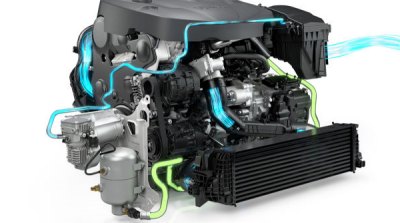 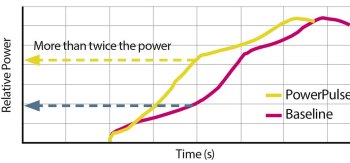 Compared with e-booster, the PowerPulse is
nearly as effective, but it costs less to make and is easier to be
installed on current cars. Volvo equipped it first on the S90/V90 D5
sequential twin-turbo diesel four-cylinder, on which it is capable to
double the power at 1 second after standing start. The only concern is
its influence to the exhaust gas mixing, which may complicate the
aftertreatment strategy.
|
||
| Copyright© 1997-2017 by Mark Wan @ AutoZine |